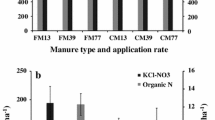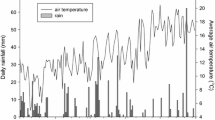Abstract
Proper management of manure nitrogen (N) requires the ability to match the rate and extent of manure N availability with crop needs. This includes recognizing the potential importance of N contributions from residual manure N that accumulates with repeated applications. Nitrogen availability relative to barley needs was assessed in plots with 13–16 years continuous histories of contrasting manure-based (solid-bedded beef) and fertilizer-based soil treatments in the Maine Potato Ecosystem Project. Soil and barley samples were collected every 7–14 days during 2003–2005, and once in 2006. Barley dry matter and N content were equivalent between the two systems. In the manure-based system, temporal patterns of N availability were more synchronous with early season crop needs than in the fertilizer-based system, but continued mineralization after harvest was also observed. In 2004–2006, samples were collected from subplots where manure/fertilizer was withheld to estimate the proportion of available N originating from current versus previous manure applications. Apparent N recovery of current years’ applications of manure organic N was 8–11% and less than predicted by a standard decay series model for beef manure (25%), highlighting the need to adjust manure N credits for crops with shorter growing seasons and lower N uptake capacities than corn. The relative contribution of residual manure N to total manure N uptake was greater than predicted from the decay series model, providing support for a residual N effect from repeated manure applications that is not accounted for in standard manure recommendations.



Similar content being viewed by others
Abbreviations
- DM:
-
Dry matter
- MPEP:
-
Maine potato ecosystem project
- Ni :
-
Inorganic N
- SOC:
-
Soil organic carbon
References
Alyokhin A, Porter G, Groden E, Drummond F (2005) Colorado potato beetle response to soil amendments: a case in support of the mineral balance hypothesis? Agric Ecosyst Environ 109:234–244
Blake GR, Hartge KH (1986) Bulk density. In: Klute A (ed) Methods of soil analysis. Part 1. Physical and mineralogical methods. ASA and SSSA, Madison, pp 363–375
Castellanos JZ, Pratt PF (1981) Mineralization of manure nitrogen–correlation with laboratory indexes. Soil Sci Soc Am J 45:354–357
Christensen BT (2004) Tightening the nitrogen cycle. In: Schjønning P et al (eds) Managing soil quality: challenges in modern agriculture. CAB International, Wallingford, pp 47–66
Gallandt ER, Mallory EB, Alford AR, Drummond FA, Groden E, Liebman M, Marra MC, McBurnie JC, Porter GA (1998) Comparison of alternative pest and soil management strategies for Maine potato production systems. Am J Alt Ag 13:146–161
Glendining MJ, Poulton PR, Powlson DS, Jenkinson DS (1997) Fate of 15N-labelled fertilizer applied to spring barley grown on soils of contrasting nutrient status. Plant Soil 195:83–98
Hoskins BR (1997) Soil testing handbook for professionals in agriculture, horticulture, nutrient and residuals management, 3rd edn. Maine Agricultural and Forest Experiment Station, Orono
Janzen HH, Beauchemin KA, Bruinsma Y, Campbell CA, Desjardins RL, Ellert BH, Smith EG (2003) The fate of nitrogen in agroecosystems: an illustration using Canadian estimates. Nutr Cycl Agroecosyst 67:85–102
Jensen B, Sørensen P, Thomsen IK, Jensen ES, Christensen BT (1999) Availability of nitrogen in 15N-labeled ruminant manure components to successively grown crops. Soil Sci Soc Am J 63:416–423
Johansson G (1992) Below-ground carbon distribution in barley (Hordeum vulgare L.) with and without nitrogen fertilization. Plant Soil 144:93–99
Ketterings QM, Albrecht G, Czymmek K, Bossard S (2005) Nitrogen credits from manure Fact Sheet 4. Cornell University Cooperative Extension, Ithaca
Klausner S, Bouldin D (1983) Soil fertility, managing animal manure. Part II: field management. Cornell University Cooperative Extension, Ithaca
Klausner SD, Rao Kanneganti V, Bouldin DR (1994) An approach for estimating a decay series for organic nitrogen in animal manure. Agron J 86:897–903
Laboski CAM, Peters JB, Bundy LG (2006) Nutrient application guidelines for field, vegetable, and fruit crops in Wisconsin. University of Wisconsin Extension, Madison
Langmeier M, Frossard E, Kreuzer M, Mäder P, Dubois D, Oberson A (2002) Nitrogen fertilizer value of cattle manure applied on soils originating from organic and conventional farming systems. Agronomie 22:789–800
Leikam DF, Lamond RE (2003) Estimating manure nutrient availability. Kansas State University, Manhattan
Ma BL, Dwyer LM, Gregorich EG (1999) Soil nitrogen amendment effects on seasonal nitrogen mineralization and nitrogen cycling in maize production. Agron J 91:1003–1009
Magdoff FR (1978) Influence of manure application rates and continuous corn on soil-N. Agron J 70:629–632
Magdoff F (1991) Managing nitrogen for sustainable corn systems: problems and possibilities. Am J Alt Ag 6:3–8
Mallory EB, Griffin TS (2007) Impacts of soil amendment history on nitrogen availability from manure and fertilizer. Soil Sci Soc Am J 71:964–973
Mallory EB, Porter GA (2007) Potato yield stability under contrasting soil management strategies. Agron J 99:501–510
Naylor R, Steinfeld H, Falcon W, Galloway J, Smil V, Bradford E, Alder J, Mooney H (2005) Losing the links between livestock and land. Science 310:1621–1622
Nelson D, Sommers L (1996) Total carbon, organic carbon, and organic matter. In: Sparks D et al (eds) Methods of soil analysis, Part 3. Chemical methods. Soil Science Society of America, Inc., Madison, pp 961–1010
Porter GA (1996) General methods. In: Marra MC (ed) The ecology, economics, and management of potato cropping systems: a report of the first 4 years of the Maine Potato Ecosystem Project. Maine Agricultural and Forest Experiment Station Bulletin 843, Orono, pp 161–174
Porter GA, McBurnie JC (1996) Crop and soil research. In: Marra MC (ed) The ecology, economics, and management of potato cropping systems: a report of the first 4 years of the Maine Potato Ecosystem Project. Maine Agricultural and Forest Experiment Station Bulletin 843, Orono, pp 8–62
Pratt PF, Broodbent FE, Martin JP (1973) Using organic wastes as nitrogen fertilizers. Calif Agric 27:10–13
Roth GW, Fox RH (1990) Soil nitrate accumulations following nitrogen-fertilized corn in Pennsylvania. J Environ Qual 19:243–248
Russelle MP, Entz MH, Franzluebbers AJ (2007) Reconsidering integrated crop-livestock systems in North America. Agron J 99:325–334
Schröder J (2005) Revisiting the agronomic benefits of manure: a correct assessment and exploitation of its fertilizer value spares the environment. Bioresource Technol 96:253–261
Schröder J, Uenk D, Hilhorst G (2007) Long-term nitrogen fertilizer replacement value of cattle manures applied to cut grassland. Plant Soil 299:83–99
Whalen J, Chang C, Olson B (2001) Nitrogen and phosphorus mineralization potentials of soils receiving repeated annual cattle manure applications. Biol Fertil Soil 34:334–341
Zebarth BJ, Leclerc Y, Moreau G, Gareau R, Milburn PH (2003) Soil inorganic nitrogen content in commercial potato fields in New Brunswick. Can J Soil Sci 83:425–429
Acknowledgments
The authors thank A. Randall Alford, Francis A. Drummond, M. S. Erich, Eric R. Gallandt, Eleanor Groden, David A. Lambert, Matt Liebman, Michele C. Marra, Jeffrey C. McBurnie, Bacilio Salas and many others for creating and overseeing the Maine Potato Ecosystem Project, Melissa Albert for her technical assistance with this research, and Sue Erich, Michel Cavigelli, and Bryan Dail for reviewing the manuscript. This research was supported in part by USDA-CSREES-IFAFS no. 2001-52101-11308 and the Maine Potato Board.
Author information
Authors and Affiliations
Corresponding author
Rights and permissions
About this article
Cite this article
Mallory, E.B., Griffin, T.S. & Porter, G.A. Seasonal nitrogen availability from current and past applications of manure. Nutr Cycl Agroecosyst 88, 351–360 (2010). https://doi.org/10.1007/s10705-010-9361-9
Received:
Accepted:
Published:
Issue Date:
DOI: https://doi.org/10.1007/s10705-010-9361-9




